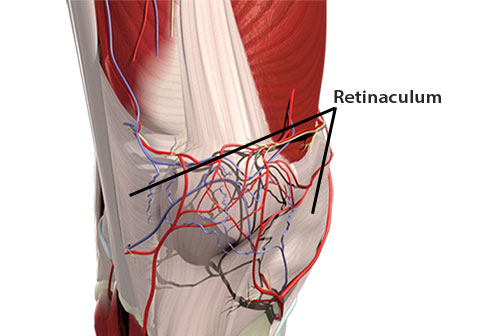Working the patellar retinaculum
- Whitney Lowe
The quadriceps muscles play a crucial role in lower extremity movement and stability. They are a central focus in walking, running, and jumping. Issues within this muscle group can lead to significant conditions, such as patellar tendinosis, chondromalacia, and patellofemoral pain syndrome (PFPS). PFPS is a condition characterized by anterior knee pain, often linked to improper patellar tracking. This condition can be challenging to address because there usually is no direct correlation between tissue damage in knee structures and pain intensity.
Frequently the anterior knee pain of PFPS is not caused by specific tissue damage. Instead, the pain may be more of a protective response to biomechanical loads. Consequently, detailed and specific work on all the tissues around the patellofemoral junction is quite helpful in addressing this type of knee pain.
Even with the uncertainty around the pain origin in PFPS, the soft tissues of the knee extensor complex (quadriceps and associated tendon and retinacula) are still viewed as a key to effective treatment of anterior knee pain of PFPS.
The other conditions mentioned above, like patellar tendinosis, chondromalacia patellae, and other knee complaints, also benefit from massage treatments aimed at the soft tissues around the knee. Let’s now look at some key strategies for addressing the distal quadriceps and retinacular tissues to address anterior knee pain.
Anatomy
The quadriceps group contains some of the largest muscles in the body. They are highly active during lower extremity locomotion, such as running, jumping, and even in simple activities like walking. Problems in the quadriceps group can often lead to anterior knee complaints.
The quadriceps insert into the proximal tibia at the tibial tuberosity by way of the patellar tendon. However, a broad expanse of connective tissue extends from the distal quadriceps to the proximal tibia and surrounds the patella. This expanse of connective tissue is the quadriceps or patellar retinaculum (Figure 1). These retinacula tissues are richly innervated, so it stands to reason that if irritated, they may play a prominent role in anterior knee pain.

Figure 1: The Patellar Retinaculum
Treatment
The tissues of the quadriceps retinaculum are sometimes glossed over when treating knee and lower extremity complaints. While it is essential to give attention to the bellies of the quadriceps muscles and the patellar tendon, treating the retinacular connective tissues is also valuable.
Treatment can begin with broad gliding strokes to help soothe the nervous system and enhance superficial fluid mechanics. Active engagement techniques are some of the most effective means of addressing painful and problematic retinacular tissues. In these techniques, some degree of active movement is combined with the massage technique being applied. The active movement is usually performed during the eccentric action of the muscles being treated.
There are several key benefits of active engagement techniques. Using active muscle contraction puts a greater tensile load on the affected tissues you are treating, allowing your pressure to be more effectively delivered directly into those tissues. In addition, the active movement during the technique takes advantage of key pain reduction strategies, as outlined in the gate theory of pain.1
One active engagement technique that is particularly helpful for addressing dysfunction in the patellar retinaculum is shown below. The retinacular tissues can sometimes be challenging to stretch and elongate independently. Using movement with additional load is very helpful in encouraging full tissue pliability. Active engagement stripping technique is most effective when performed in conjunction with other deep work to address hypertonicity in the quadriceps muscles. Remember that active engagement increases the sensitivity level of the tissues you are working on, so check in with your client to ensure you aren’t too aggressive with your treatment.
Addressing anterior knee pain, particularly in cases like patellofemoral pain syndrome (PFPS), requires a comprehensive approach that considers the knee’s muscular and connective tissues. The quadriceps group, with its extensive involvement in lower extremity movement, is crucial in these cases. It is equally important not to overlook the role of the patellar retinaculum. Integrating techniques such as active engagement can be particularly effective in treating the often-overlooked retinacular tissues, enhancing overall tissue pliability and pain relief. By combining these targeted methods, therapists can more effectively address the complex biomechanical and neurological factors contributing to knee pain, ultimately improving client outcomes.
In our comprehensive orthopedic medical massage knee course, you can learn more about PFPS, other lower extremity conditions, and dozens of key assessment and treatment strategies for these conditions.
Resources
- Heitler B. Primary Afferent Depolarization and the Gate Control Theory of Pain: A Tutorial Simulation. J Undergrad Neurosci Educ JUNE Publ FUN Fac Undergrad Neurosci. 2023;22(1):A58-A65. doi:10.59390/PWFC1224

